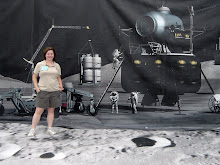
Opportunity leaves Victoria Crater. More to come.
Jet-setting planetary scientist roams the world ... and beyond.

 Today I got a call from my mom, who pleaded with me to tell her we weren't putting the little rover to sleep like a sick animal. It never fails to amaze me how much these rovers capture the public imagination. In reading the news today after she called, the media stories may have been a little out of proportion - we never had a plan to shut one rover down entirely. Anyway, looks like that letter with the funding cuts has been rescinded for now.
Today I got a call from my mom, who pleaded with me to tell her we weren't putting the little rover to sleep like a sick animal. It never fails to amaze me how much these rovers capture the public imagination. In reading the news today after she called, the media stories may have been a little out of proportion - we never had a plan to shut one rover down entirely. Anyway, looks like that letter with the funding cuts has been rescinded for now. On Feb. 22, we held an all-female uplink team for the Spirit rover! Yay! The rover science and engineering teams have a substantial number of women on them, and uplink teams have been nearly all female just by chance a good number of times, but when our only current female Mission Manager, Cindy, decided to move on to MSL, Ashley (that's her in the photo, wearing a 9-blue-diamond necklace at the Smithsonian) coordinated a true all-women uplink day. And I got to be the Science team chair! What a fantastic experience. It was so interesting to me that having all women didn't really make a difference at all to planning the day. We're all just good at our jobs and get things done! However, both rovers planned nearly identical sols and Spirit was done well before Opportunity ;) And i love being part of a team that can make history for something that we on the rover team now take for granted - that everyone brings knowledge, enthusiasm, and experience to operating these rovers - regardless of gender.
On Feb. 22, we held an all-female uplink team for the Spirit rover! Yay! The rover science and engineering teams have a substantial number of women on them, and uplink teams have been nearly all female just by chance a good number of times, but when our only current female Mission Manager, Cindy, decided to move on to MSL, Ashley (that's her in the photo, wearing a 9-blue-diamond necklace at the Smithsonian) coordinated a true all-women uplink day. And I got to be the Science team chair! What a fantastic experience. It was so interesting to me that having all women didn't really make a difference at all to planning the day. We're all just good at our jobs and get things done! However, both rovers planned nearly identical sols and Spirit was done well before Opportunity ;) And i love being part of a team that can make history for something that we on the rover team now take for granted - that everyone brings knowledge, enthusiasm, and experience to operating these rovers - regardless of gender.

